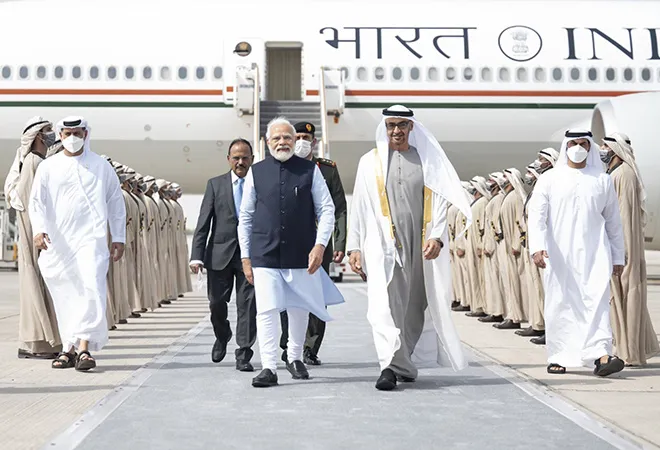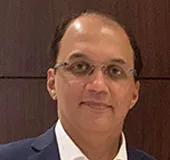-
CENTRES
Progammes & Centres
Location
Growing convergence on contemporary national goals and policy objectives has become the principal driver of the India-UAE relations

The United Arab Emirates (UAE) recently emerged as India’s fourth-largest investor. Coupled with the first anniversary of the India-UAE Comprehensive Economic Partnership Agreement (CEPA) in May 2023, all signs point towards deeper economic integration between the two nations. Even though economic cooperation with the UAE has been a foreign policy priority for the Indian government since 2014, it is not the only cornerstone in the bilateral relationship, which is multifaceted as it is resilient. The foundation of this resilient partnership dates back to 3000 BCE when Indian fishermen and merchants traded on the shores of the present-day UAE, which was formalised in 1972 with the establishment of India-UAE diplomatic relations. Even as historic ties deepen the bilateral relationship, growing convergence on contemporary national goals and policy objectives are now the principal drivers of this enduring association.
The UAE’s current President, Sheikh Mohamed bin Zayed Al-Nahyan, launched the Centennial Plan 2071 in 2021. With a five-decade vision based on six pillars, it lays the road map to augment the country's reputation as a reliable soft power. It envisions equipping the country with the information and skill sets required to manifest its ambition of becoming a global soft power by 2071.
The CEPA aims to reduce and eventually eliminate up to 10,000 tariffs between the economies, propelling bilateral trade to newer heights.
The UAE’s Centennial Plan runs concurrently with India’s Vision 2047, which has set ambitious national imperatives, ensuring prosperity and development for all its people.
The commonalities in their long-term domestic and global vision have spurred the India-UAE bilateral trade, commerce and economic ties, further strengthened during the past year following the signing of the CEPA—the UAE’s first-ever such partnership and India’s first CEPA in the GCC region. Since the operationalisation of CEPA, bilateral trade between India and the UAE has witnessed 20 percent growth over the previous year. India’s exports to the UAE also increased by 12 percent, reaching US$31.3 billion in 2022-23.
Under CEPA, the two countries aim to escalate bilateral trade to US$100 billion over the next five years and bolster supply chains. This target is on track, as the UAE is poised to emerge as India’s third-largest trading partner with a record US$88 billion bilateral trade, behind only China and the US, in 2023. Going forward, the CEPA aims to reduce and eventually eliminate up to 10,000 tariffs between the economies, propelling bilateral trade to newer heights. Speaking at the India-UAE Partnership Summit 2023, India’s Minister for Commerce and Industry, Piyush Goyal, highlighted that CEPA will harness the entrepreneurship and complementary economic goals of the bilateral partners. He also said that the CEPA partners will deepen cooperation in rupee-dirham trade, digital trade and food corridors, green energy, and connectivity infrastructure.
Besides bilateral economic integration, the partners have also played on their economies’ complementarity. As industrial and manufacturing capacity booms in India, the UAE has proven to be a reliable and resilient energy exporter. The UAE has emerged as India’s third-largest source of oil behind Saudi Arabia and Iraq. During Indian Prime Minister Narendra Modi’s third visit to UAE in February 2018, the Indian Strategic Petroleum Reserves Ltd (ISPRL) and the UAE’s Abu Dhabi National Oil Company (ADNOC) inked an agreement detailing constant pricing and oil supply. Under this agreement, ADNOC will invest US$400 million to store crude in ISPRL’s underground rock caverns. Such contracts not only underline economic complementaries but also showcase energy security as an essential pillar of the bilateral relationship.
As industrial and manufacturing capacity booms in India, the UAE has proven to be a reliable and resilient energy exporter.
India and the UAE also find a common footing on the emerging international strategic culture and multilateral reforms. The bilateral partners have voiced similar opinions on strategic issues such as the US dollar’s dominance in international trade, terrorism, and ending the hostilities in Ukraine. The bilateral partners also wish for a rules-based international order that prescribes and acknowledges emerging economies’ more significant role in the global economy. These strategic convergences culminated in the formalisation of minilateral groupings, such as the India-Israel-US-UAE (I2U2) and the India-UAE-France maritime trilateral.
The I2U2, a promising initiative for economic cooperation and development, focuses on food security, energy security, water security, and climate change. The minilateral has acted swiftly and announced its first three projects in the UAE and India, with an investment of US$6 billion in desalination plants, clean energy projects, and food parks. India, the UAE, and France recently conducted their maiden trilateral maritime exercise in the Gulf of Oman, signalling their willingness to collectively tackle traditional and non-traditional strategic challenges in the maritime sphere.
The bilateral partners also wish for a rules-based international order that prescribes and acknowledges emerging economies’ more significant role in the global economy.
Increasing high-level government interactions have forged the bilateral partners’ strategic convergences and mutually beneficial agreements. Prime Minister Narendra Modi visited the UAE four times between 2014 and 2022, and the rulers of the UAE have reciprocated with four high-level visits to India in the same period. Prime Minister Modi also last visited the UAE to offer his condolences on the demise of the former UAE President and ruler of Abu Dhabi, Sheikh Khalifa bin Zayed Al Nahyan. These gestures signal a political friendship and ideological concurrence.
Besides the convergences at the national level, India’s engagement with the UAE at a sub-national level has also been pivotal for the India-UAE bilateral relationship, with the Indian diaspora and remittances providing a bridge between the two countries. Chief Minister of Kerala, Pinarayi Vijayan, has hailed the UAE’s ties with Kerala as a “heart-to-heart relationship”. Besides the presence of a large number of Keralite expatriates, whose contribution to the UAE’s economy has been recognised by the UAE government, the past few years have seen an increasing number of Indians from Uttar Pradesh and Telangana finding in the Emirates their new lives and livelihoods. Introducing the Gold and Green Visas will facilitate more Indian talent, especially entrepreneurs, to expand their footprint in the Emirates fintech and startup sectors. The opening of the first overseas campus of the Indian Institute of Technology in Abu Dhabi in 2024 will strengthen people-to-people ties and foster youth engagement.
Introducing the Gold and Green Visas will facilitate more Indian talent, especially entrepreneurs, to expand their footprint in the Emirates fintech and startup sectors.
As a partnership built on civilisational ties and aligning interests, the India-UAE bilateral can also have a positive global impact – for example, the India-UAE joint developmental projects in Africa. In September 2022, India’s External Affairs Minister S Jaishankar and his UAE counterpart, Sheikh Abdullah bin Zayed Al Nahyan, discussed strengthening the bilateral with joint initiatives in the developmental sector in Kenya and Tanzania and exploring collaborative projects for food security in Africa within the I2U2 framework. This assurance came on the heels of a joint high-level delegation meeting Tanzania’s health minister, Ummy Mwalimu, to discuss specific projects for cooperation with the government and private sector healthcare providers in the East African country.
Business analysts are also upbeat about the CEPA not only opening India’s access to the UAE market but also helping to expand the footprint of Indian startups in other geographies in West Asia and North Africa.
As India forges its path ahead, leading the G20 in these tumultuous times, the UAE remains its steadfast political, cultural, and economic partner. The fundamentals of economic engagement, diaspora relations, and strategic convergences have deepened the India-UAE ties over the past 10 years. The bilateral is set to become stronger as CEPA finds deeper roots and steers each partner’s policy apparatuses and businesses towards more prosperous, mutually-beneficial, and meaningful engagement.
Dinesh N Joshi is Chairman SatyaGiri Group and President, International Business Linkage Forum (India-UAE Partnership Summit); Chairman, International Business Committee, IMC Chamber of Commerce & Industry and Member, National Executive Committee, FICCI.
Prithvi Gupta is a Research Assistant at the Observer Research Foundation
The views expressed above belong to the author(s). ORF research and analyses now available on Telegram! Click here to access our curated content — blogs, longforms and interviews.

Prithvi Gupta is a Junior Fellow with the Observer Research Foundation’s Strategic Studies Programme. Prithvi works out of ORF’s Mumbai centre, and his research focuses ...
Read More +
Dinesh N Joshi is Chairman SatyaGiri Group and President of the International Business Linkage Forum (India-UAE Partnership Summit): Chairman International Business Committee IMC Chamber of ...
Read More +